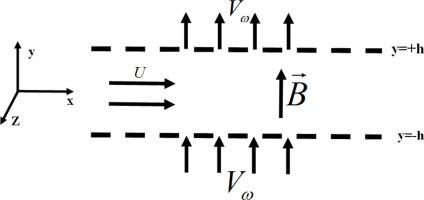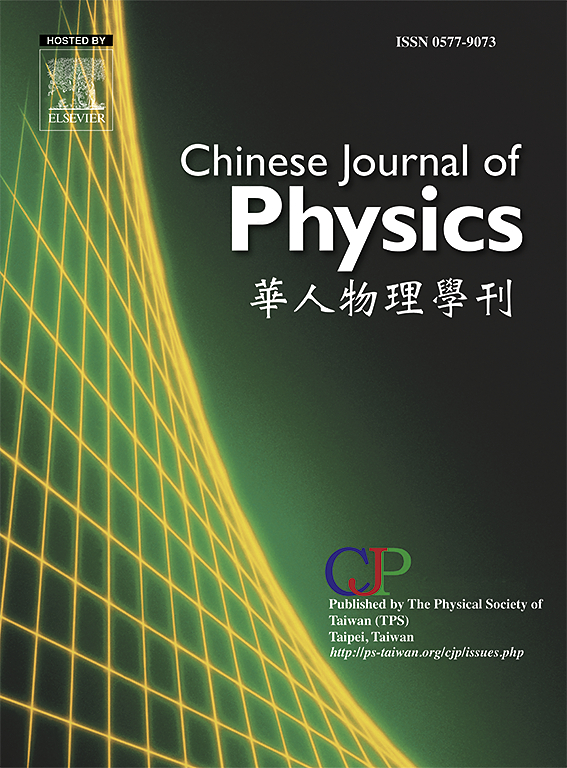黏弹性Kelvin-Voigt流体在各向异性多孔介质中磁、小吸、注作用下的稳定性分析
IF 4.6
2区 物理与天体物理
Q1 PHYSICS, MULTIDISCIPLINARY
引用次数: 0
摘要
流体在多孔介质中的流动是许多科学和工程应用的基础,包括电色谱、微泵系统、地下地质过程、聚合物处理和污染土壤修复。这些系统通常涉及粘弹性流体,如聚合物溶液、乳液、悬浮液和生物流体,其复杂的流变性能显著影响流动动力学。本文对各向异性多孔介质中粘弹性Kelvin-Voigt流体在均匀横向磁场作用下的线性稳定性进行了全面分析。利用正态分析导出了一个改进的Orr-Sommerfeld特征值问题,并采用切比雪夫谱配置法进行了数值求解。系统地研究了扰动增长率、临界雷诺数和不稳定阈值的分布,包括Kelvin-Voigt弛豫时间、达西数、注入/吸入雷诺数、各向异性系数、波数和哈特曼数等关键参数。分析表明,较高的达西数和波数使流动趋于稳定,而适度的注射/吸力通过提高临界雷诺数和延迟不稳定发生来提高稳定性。横向磁场通过洛伦兹力效应减少了流动干扰,降低了动能,促进了层流。相反,力学各向异性增强了速度波动,使流动不稳定。这些结果加深了对粘弹性介质稳定性机制的理解,并与聚合物挤出、MHD输送、核冷却系统、化学反应堆以及航空航天和生物医学工程中的先进制造工艺等应用相关。本文章由计算机程序翻译,如有差异,请以英文原文为准。

Stability analysis of viscoelastic Kelvin–Voigt fluid in anisotropic porous media in the presence of hydromagnetic, small suction and injection effect
The flow of fluids through porous media is fundamental to many scientific and engineering applications, including electrochromatography, micropumping systems, subsurface geological processes, polymer processing, and contaminated soil remediation. These systems often involve viscoelastic fluids such as polymer solutions, emulsions, suspensions, and biological fluids whose complex rheological properties significantly affect flow dynamics. This study offers a comprehensive linear stability analysis of a viscoelastic Kelvin–Voigt fluid flowing through an anisotropic porous medium under a uniform transverse magnetic field with boundary injection/suction effects. A modified Orr–Sommerfeld eigenvalue problem is derived using normal mode analysis and solved numerically via the Chebyshev spectral collocation method. The resulting profiles of perturbation growth rates, critical Reynolds numbers, and instability thresholds are systematically examined concerning key parameters, including the Kelvin–Voigt relaxation time, Darcy number, injection/suction Reynolds number, anisotropy coefficient, wavenumber, and Hartmann number. The analysis shows that higher Darcy and wave numbers stabilise the flow, while moderate injection/suction increases stability by raising the critical Reynolds number and delaying instability onset. The transverse magnetic field reduces flow disturbances through Lorentz force effects, decreasing kinetic energy and fostering laminar flow. Conversely, mechanical anisotropy enhances velocity fluctuations and destabilises the flow. These results deepen the understanding of stability mechanisms in viscoelastic media and are relevant for applications such as polymer extrusion, MHD transport, nuclear cooling systems, chemical reactors, and advanced manufacturing processes in aerospace and biomedical engineering.
求助全文
通过发布文献求助,成功后即可免费获取论文全文。
去求助
来源期刊

Chinese Journal of Physics
物理-物理:综合
CiteScore
8.50
自引率
10.00%
发文量
361
审稿时长
44 days
期刊介绍:
The Chinese Journal of Physics publishes important advances in various branches in physics, including statistical and biophysical physics, condensed matter physics, atomic/molecular physics, optics, particle physics and nuclear physics.
The editors welcome manuscripts on:
-General Physics: Statistical and Quantum Mechanics, etc.-
Gravitation and Astrophysics-
Elementary Particles and Fields-
Nuclear Physics-
Atomic, Molecular, and Optical Physics-
Quantum Information and Quantum Computation-
Fluid Dynamics, Nonlinear Dynamics, Chaos, and Complex Networks-
Plasma and Beam Physics-
Condensed Matter: Structure, etc.-
Condensed Matter: Electronic Properties, etc.-
Polymer, Soft Matter, Biological, and Interdisciplinary Physics.
CJP publishes regular research papers, feature articles and review papers.
 求助内容:
求助内容: 应助结果提醒方式:
应助结果提醒方式:


